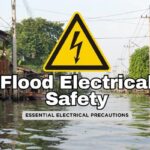Flooding is devastating enough, but the hidden danger comes after the water recedes—mold. In as little as 24 to 48 hours, mold spores can take hold, spreading rapidly and causing serious health risks and structural damage. If you’ve experienced a flood, acting fast is critical to prevent long-term issues. Here’s how to tackle mold head-on and protect your home and health.
Mold exposure can cause health problems, especially for those with respiratory issues or weakened immune systems. If mold covers more than 10 square feet or is in HVAC systems, consult a professional remediation service.
1️⃣ Remove Standing Water Immediately
The longer water sits, the worse mold gets. Stagnant water creates the perfect breeding ground for mold spores, allowing them to spread within hours. Removing floodwater quickly is the first and most important step.
How to Do It:
- Use a sump pump or wet/dry vacuum for large amounts of water.
- Open doors and windows to increase ventilation.
- If safe, use mops and towels to absorb excess moisture in smaller areas.
- Dispose of any contaminated absorbent materials like carpets and insulation.
💡 FloodMart Tip: If flooding is severe, call a water damage restoration company to pump out water safely and efficiently.
2️⃣ Dry Everything Thoroughly
Even after removing the water, humidity and residual moisture can fuel mold growth. Drying out your home fast is essential.
How to Do It:
- Use high-powered fans and dehumidifiers to accelerate drying.
- Open windows and doors to improve air circulation.
- Remove wet furniture, rugs, and curtains and place them in direct sunlight if possible.
- If drywall or insulation is saturated, cut it out and replace it to prevent hidden mold.
💡 FloodMart Tip: A humidity level below 50% will help stop mold from spreading. Use a hygrometer to monitor moisture levels.
3️⃣ Remove Contaminated Materials
Not everything can be saved after a flood. Porous materials like drywall, carpet, and insulation trap moisture and become mold-infested quickly. Keeping them puts your home at risk for long-term mold problems.
What to Toss:
- Carpets & Padding – Mold grows in fibers and is nearly impossible to clean thoroughly.
- Drywall & Insulation – Once soaked, they can’t be dried effectively and should be replaced.
- Upholstered Furniture & Mattresses – These hold moisture deep inside, making them a breeding ground for mold.
- Cardboard & Paper Products – Items like books and boxes soak up water instantly and should be discarded.
💡 FloodMart Tip: Use thick plastic bags to seal mold-contaminated items before disposal to prevent spores from spreading.
4️⃣ Scrub and Disinfect All Surfaces
Once wet materials are removed, it’s time for a deep clean. Mold spores stick to surfaces even after drying, so scrubbing and disinfecting every exposed area is essential.
How to Do It:
- Mix one cup of bleach per gallon of water and scrub walls, floors, and hard surfaces.
- Use white vinegar or hydrogen peroxide for a less toxic but effective alternative.
- Wear gloves and an N95 mask to protect yourself from exposure.
- Let the solution sit for at least 10 minutes before wiping it down.
💡 FloodMart Tip: Never mix bleach with ammonia—this creates a toxic gas that can be deadly.
5️⃣ Use HEPA Air Purifiers to Trap Mold Spores
Even after cleaning, airborne mold spores can linger, making it crucial to filter the air to prevent further contamination.
How to Do It:
- Use a HEPA (High-Efficiency Particulate Air) purifier to capture tiny mold spores.
- Place purifiers in heavily affected areas, like basements or damp rooms.
- Keep air moving by running fans and dehumidifiers to maintain dryness.
💡 FloodMart Tip: A HEPA vacuum can help remove mold spores from carpets, furniture, and vents. Regular vacuums won’t trap microscopic spores effectively.
6️⃣ Check HVAC Systems for Mold Growth
Flooding can send moisture and mold spores into your HVAC system, allowing them to spread throughout your home every time the air turns on.
How to Do It:
- Turn off the HVAC system immediately if flooding reached your vents.
- Remove and replace wet air filters and inspect ductwork for visible mold.
- Hire a professional duct cleaning service if mold is detected in vents.
- Use HVAC-grade disinfectants to clean accessible components like vents and grilles.
💡 FloodMart Tip: Running an HVAC UV light system can help kill mold spores before they circulate through your home.
7️⃣ Seal and Repair Any Water Leaks
Even after flood cleanup, hidden leaks and moisture buildup can invite mold back into your home. Prevent future outbreaks by sealing and repairing all potential problem areas.
How to Do It:
- Inspect walls, ceilings, and floors for signs of lingering moisture.
- Seal any foundation cracks that allow water to seep in.
- Replace or repair leaky pipes, roofs, or windows.
- Apply waterproof sealant to vulnerable areas like basements and crawl spaces.
💡 FloodMart Tip: Use a moisture meter to detect hidden damp spots before mold takes hold.
8️⃣ Dehumidify and Keep Air Dry
Mold thrives in humid environments, so keeping indoor humidity below 50% is essential. A dehumidifier can make all the difference in preventing mold regrowth.
How to Do It:
- Run a dehumidifier in damp areas like basements and bathrooms.
- Use exhaust fans when cooking, showering, or doing laundry.
- Keep closets and storage areas ventilated to prevent musty smells.
💡 FloodMart Tip: If your home still feels humid, place moisture absorbers like silica gel or activated charcoal in problem areas.
9️⃣ Use Mold-Resistant Materials for Repairs
If flooding caused damage that requires rebuilding, now is the time to use mold-resistant materials to protect your home long-term.
How to Do It:
- Replace drywall with mold-resistant drywall or cement board.
- Use mold-inhibiting paint in high-humidity areas.
- Install moisture-resistant insulation like closed-cell foam.
- Choose tile or vinyl flooring instead of carpet in flood-prone areas.
💡 FloodMart Tip: If you’re in a high-risk flood zone, elevate appliances and electrical systems to minimize future flood damage.
🔟 Call a Professional for Severe Mold Infestations
If mold has spread beyond 10 square feet, entered HVAC systems, or caused health symptoms, it’s time to call in a professional remediation team.
How to Do It:
- Look for certified mold remediation experts with experience in flood damage.
- Ensure they use HEPA air scrubbers and professional-grade disinfectants.
- Request air quality testing before and after remediation.
- Follow their guidance on any necessary home repairs or material replacements.
💡 FloodMart Tip: If you have flood insurance, check if your policy covers mold remediation costs before hiring a service.
Dealing with mold after a flood can’t wait—the longer it lingers, the worse the damage and health risks. Acting fast with water removal, thorough drying, and mold prevention can protect your home and loved ones. Whether it’s DIY cleaning or professional remediation, tackling mold head-on ensures a safer, healthier recovery.



